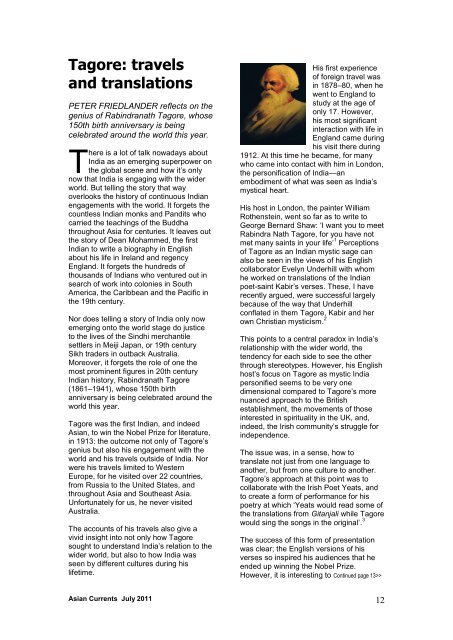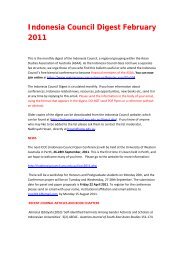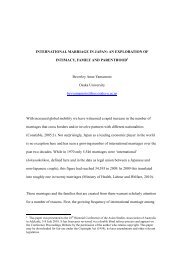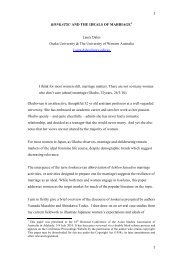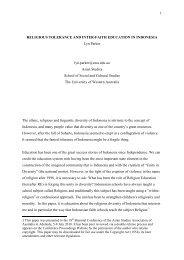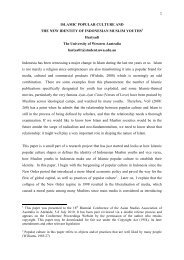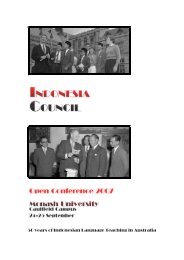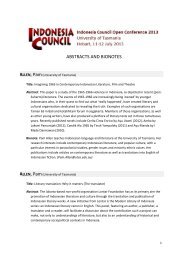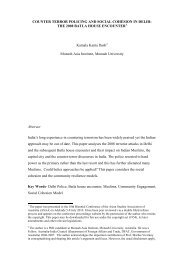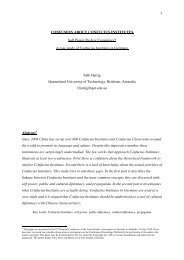Asian Currents - Asian Studies Association of Australia
Asian Currents - Asian Studies Association of Australia
Asian Currents - Asian Studies Association of Australia
You also want an ePaper? Increase the reach of your titles
YUMPU automatically turns print PDFs into web optimized ePapers that Google loves.
Tagore: travels<br />
and translations<br />
PETER FRIEDLANDER reflects on the<br />
genius <strong>of</strong> Rabindranath Tagore, whose<br />
150th birth anniversary is being<br />
celebrated around the world this year.<br />
T<br />
here is a lot <strong>of</strong> talk nowadays about<br />
India as an emerging superpower on<br />
the global scene and how it‘s only<br />
now that India is engaging with the wider<br />
world. But telling the story that way<br />
overlooks the history <strong>of</strong> continuous Indian<br />
engagements with the world. It forgets the<br />
countless Indian monks and Pandits who<br />
carried the teachings <strong>of</strong> the Buddha<br />
throughout Asia for centuries. It leaves out<br />
the story <strong>of</strong> Dean Mohammed, the first<br />
Indian to write a biography in English<br />
about his life in Ireland and regency<br />
England. It forgets the hundreds <strong>of</strong><br />
thousands <strong>of</strong> Indians who ventured out in<br />
search <strong>of</strong> work into colonies in South<br />
America, the Caribbean and the Pacific in<br />
the 19th century.<br />
Nor does telling a story <strong>of</strong> India only now<br />
emerging onto the world stage do justice<br />
to the lives <strong>of</strong> the Sindhi merchantile<br />
settlers in Meiji Japan, or 19th century<br />
Sikh traders in outback <strong>Australia</strong>.<br />
Moreover, it forgets the role <strong>of</strong> one the<br />
most prominent figures in 20th century<br />
Indian history, Rabindranath Tagore<br />
(1861–1941), whose 150th birth<br />
anniversary is being celebrated around the<br />
world this year.<br />
Tagore was the first Indian, and indeed<br />
<strong>Asian</strong>, to win the Nobel Prize for literature,<br />
in 1913: the outcome not only <strong>of</strong> Tagore‘s<br />
genius but also his engagement with the<br />
world and his travels outside <strong>of</strong> India. Nor<br />
were his travels limited to Western<br />
Europe, for he visited over 22 countries,<br />
from Russia to the United States, and<br />
throughout Asia and Southeast Asia.<br />
Unfortunately for us, he never visited<br />
<strong>Australia</strong>.<br />
The accounts <strong>of</strong> his travels also give a<br />
vivid insight into not only how Tagore<br />
sought to understand India‘s relation to the<br />
wider world, but also to how India was<br />
seen by different cultures during his<br />
lifetime.<br />
His first experience<br />
<strong>of</strong> foreign travel was<br />
in 1878–80, when he<br />
went to England to<br />
study at the age <strong>of</strong><br />
only 17. However,<br />
his most significant<br />
interaction with life in<br />
England came during<br />
his visit there during<br />
1912. At this time he became, for many<br />
who came into contact with him in London,<br />
the personification <strong>of</strong> India—an<br />
embodiment <strong>of</strong> what was seen as India‘s<br />
mystical heart.<br />
His host in London, the painter William<br />
Rothenstein, went so far as to write to<br />
George Bernard Shaw: ‗I want you to meet<br />
Rabindra Nath Tagore, for you have not<br />
met many saints in your life‘ 1 Perceptions<br />
<strong>of</strong> Tagore as an Indian mystic sage can<br />
also be seen in the views <strong>of</strong> his English<br />
collaborator Evelyn Underhill with whom<br />
he worked on translations <strong>of</strong> the Indian<br />
poet-saint Kabir‘s verses. These, I have<br />
recently argued, were successful largely<br />
because <strong>of</strong> the way that Underhill<br />
conflated in them Tagore, Kabir and her<br />
own Christian mysticism. 2<br />
This points to a central paradox in India‘s<br />
relationship with the wider world, the<br />
tendency for each side to see the other<br />
through stereotypes. However, his English<br />
host‘s focus on Tagore as mystic India<br />
personified seems to be very one<br />
dimensional compared to Tagore‘s more<br />
nuanced approach to the British<br />
establishment, the movements <strong>of</strong> those<br />
interested in spirituality in the UK, and,<br />
indeed, the Irish community‘s struggle for<br />
independence.<br />
The issue was, in a sense, how to<br />
translate not just from one language to<br />
another, but from one culture to another.<br />
Tagore‘s approach at this point was to<br />
collaborate with the Irish Poet Yeats, and<br />
to create a form <strong>of</strong> performance for his<br />
poetry at which ‗Yeats would read some <strong>of</strong><br />
the translations from Gitanjali while Tagore<br />
would sing the songs in the original‘. 3<br />
The success <strong>of</strong> this form <strong>of</strong> presentation<br />
was clear; the English versions <strong>of</strong> his<br />
verses so inspired his audiences that he<br />
ended up winning the Nobel Prize.<br />
However, it is interesting to Continued page 13>><br />
<strong>Asian</strong> <strong>Currents</strong> July 2011 12


